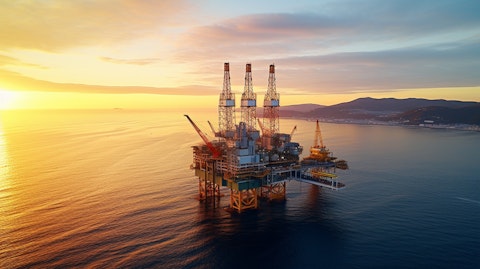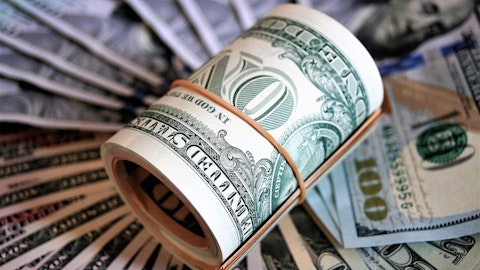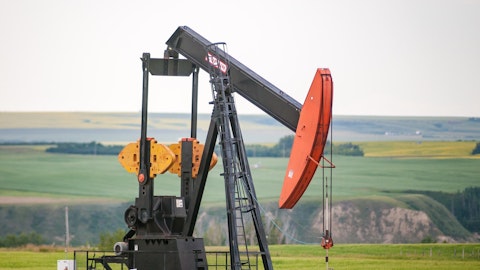Energy Transfer LP (NYSE:ET) Q3 2023 Earnings Call Transcript November 1, 2023
Energy Transfer LP beats earnings expectations. Reported EPS is $0.33, expectations were $0.29.
Operator: Good day, and welcome to the Energy Transfer Third Quarter 2023 Earnings Conference Call. All participants will be in listen-only mode. [Operator Instructions] After today’s presentation, there will be an opportunity to ask questions. Please note that this event is being recorded. I would like to turn the call over to Mr. Tom Long, Co-CEO of Energy Transfer. Please go ahead.
Tom Long: Thank you, Operator, and good afternoon everyone. Welcome to the Energy Transfer’s third quarter 2023 earnings call. I’m also joined today by Mackie McCrea and other members of the senior management team who are here to help answer your questions after our prepared remarks. Hopefully, you saw the press release we issued earlier this afternoon as well as the slides posted to our Web site. As a reminder, we will be making forward-looking statements within the meaning of Section 21E of the Securities Exchange Act of 1934. These statements are based upon our current beliefs as well as certain assumptions and information currently available to us and are discussed in more detail in our Form 10-Q for the quarter ended September 30, 2023, which we expect to file tomorrow November 2.
I’ll also refer to adjusted EBITDA and distributable cash flow or DCF, both of which are non-GAAP financial measures. You’ll find a reconciliation of our non-GAAP financial measures on our Web site. We will start today by going over our financial results for the third quarter of 2023. We generated adjusted EBITDA of $3.5 billion, compared to $3.1 billion for the third quarter of 2022. In our base business, we had strong performance across our operations, including record volumes through our NGL pipelines, fractionators, and NGL and refined products’ terminals, as well as record volumes in our crude segment. In addition, volumes in our intrastate and midstream segments remained near records. DCF attributable to the partners of Energy Transfer as adjusted was $2 billion, compared to $1.6 billion for the third quarter of 2022.
This resulted in excess cash flow after distributions of $1 billion. On October 20, we announced a quarterly cash distribution of $0.3125 per common unit or $1.25 on an annualized basis. This distribution represents an increase from the $0.2650 in the third quarter of 2022. In August, Energy Transfer’s senior unsecured credit rating was upgraded by S&P to BBB with a stable outlook. We are pleased to have this third-party recognition of all the hard work that we have done over the last several years, and as we have placed significant focus on our balance sheet in leverage reduction. As of September 30, 2023, the total available liquidity under our revolving credit facility was approximately $2.12 billion. During the third quarter of 2023, we spent $418 million on organic growth capital.
And in October, we completed the sale of $4 billion of aggregate principal amount of senior notes, and used the proceeds to repay borrowings on our revolving credit facility, and pre-funded 2024 maturities. Now turning to our results by segment for the third quarter, starting with NGL and refined products, adjusted EBITDA was $1.1 billion compared to $634 million for the third quarter of 2022. This was primarily due to strong performances across our transportation, storage, terminal, and fractionation operations. We also saw strong contributions from our optimization of hedged NGL and refined products inventories, where we recorded $107 million in marketing margin compared to a loss of $126 million in the third quarter of last year. NGL transportation volumes on our wholly-owned and joint venture pipelines increased 14% to a record 2.2 million barrels per day, compared to 1.9 million barrels per day for the same period last year.
This increase was primarily due to higher volumes from the Permian region and on our NGL pipelines that delivered into our Nederland Terminal, as well as on the Mariner East pipeline system. Average fractionated volumes increased 9% to a record 1 million barrels per day, compared to 940,000 barrels per day for the same period last year. Total NGL export volumes grew more than 20% over the third quarter of 2022, setting a new partnership record. This was primarily driven by increased international demand for NGLs. Through the first nine months of this year, we loaded more than 47 million barrels of ethane out of Nederland, and approximately 21 million barrels of ethane out of Marcus Hook. In total, we continue to export more NGLs than any other company during the third quarter, and maintained an approximately 20% market share of worldwide NGL exports, as well as nearly 40% of U.S. exports.
For midstream, adjusted EBITDA was $631 million compared to $868 million for the third quarter of 2022. We saw near record throughput again this quarter, which was the result of growth in the majority of our operating regions. The strong volume growth was more than offset by significantly lower natural gas and NGL prices. Gathered gas volumes increased 4% to 19.8 million MMBtus per day, compared to 19.1 MMBtus per day for the same period last year. For our crude oil segment, adjusted EBITDA was $706 million compared to $461 million for the third quarter of 2022. This was primarily due to higher volumes on several of our pipelines, as well as the acquisition of the Lotus assets in May of this year. In addition, G&A expenses decreased $126 million as a result of a one-time charge related to the resolution of a legal matter in the prior period.
Crude oil transportation volumes were a record 5.6 million barrels per day, compared to 4.6 million barrels per day for the same period last year. This was a result of higher volumes on our Texas pipeline systems, the Bakken Pipeline, as well as the acquisition of the Lotus assets in May of this year. In our interstate segment, adjusted EBITDA was $491 million, compared to $409 million in the third quarter of 2022. This increase was primarily due to placing the Gulf Run Pipeline into service in December of 2022, as well as higher contracted volumes and interruptible utilization on several of our wholly-owned and joint venture pipeline. Volumes increased 15% over the same period last year due to the Gulf Run Pipeline being placed into service, as well as higher utilization on many of our interstate pipeline, including Transwestern, Rover, Panhandle and Trunkline.
We continue to fully utilize Zone 1 capacity on Gulf Run, and we are also maximizing deliveries into our Trunkline Pipeline from Zone 2. And for our intrastate segment, adjusted EBITDA was $244 million, compared to $301 million in the third quarter of last year. Benefits from favorable storage optimization and new contracts on our Texas and Haynesville pipelines as well as lower operating expenses were more than offset by decreases resulting from lower spreads across our intrastate pipeline network, and lower natural gas pricing. Now, turning to our acquisition of Crestwood Equity Partners, which we announced in August of this year, as many of you have probably seen, earlier this week, Crestwood unit holders voted to approve the merger between Energy Transfer and Crestwood.

The acquisition is expected to be immediately accretive to DCF per unit upon closing. In addition, this transaction will extend Energy Transfer’s position in the value chain deeper into the Williston and Delaware basins, while also providing entry into the Powder River Basin. These assets are expected to compliment Energy Transfer’s downstream fractionation capacity at Mont Belvieu, as well as its hydrocarbon export capabilities from both our Nederland and Marcus Hook terminals. We also expect benefits within our NGL and refined products and crude oil businesses with the addition of strategically located storage in terminal assets. We now expect the acquisition to close on November 3, and we expect to achieve approximately $40 million in annual cost synergies before additional anticipated benefits from financial and commercial synergies.
Turning to our growth projects and starting with our Nederland and Marcus Hook export terminals, September and October were our best months ever across our NGL export terminals. And these terminals continue to benefit from increased demand, both in the U.S. and as well as from international customers. Earlier this year, we FID’d an expansion to our NGL export capacity at Nederland in order to address the growing demand. We expect this expansion, which is projected to cost approximately $1.25 billion, to add up to 250,000 barrels per day of export capacity. The project is expected to be in service in mid 2025, and will give us flexibility to load various products based upon customer demand. Construction is underway, and we look forward to providing more specifics on this expansion as it progresses.
We also continue to pursue an optimization project at our Marcus Hook Terminal that we project would add incremental ethane refrigeration and storage capacity. At Mont Belvieu, we placed Frac VIII into service in August, which brought our total Mont Belvieu fractionation capacity to over 1.15 million barrels per day. As a result, in October, throughput at our fractionators reached an all-time high. Out in the Delaware Basin, we have placed 200 million cubic foot per day processing plants into service since December of 2022, and we now have a total of eight — 200 million cubic foot per day processing plants operating in the Delaware Basin. Our plant inlet remains near record highs, and we continue to contemplate the necessity and potential timing of adding another processing plant in the Permian Basin while considering any available new capacity that we acquire via the Crestwood acquisition.
Next, an update on our Lake Charles LNG project; we continue to see significant interest in our LNG capacity from U.S. producers and international markets. We are in negotiations with several significant equity partners that are ultimately targeting retaining an interest of approximately 20% for Energy Transfer. These potential equity partners are also interested in substantial volumes of LNG offtake. We are in negotiations to finalize our EPC contract, and we are receiving tremendous support from domestic and international customers, community stakeholders, and other interested constituents who are actively encouraging the Department of Energy to approve our pending export authorization application on an expedited basis. And now for an update on a few other projects on the carbon capture and sequestration front, we are continuing to make progress with CapturePoint.
This project entails the capture of CO2 from our treating plants in north Louisiana and the construction of a pipeline to a sequestration site in central Louisiana. We are continuing to work with Oxy to develop a CCS project in Lake Charles, Louisiana area. This would include the construction of a CO2 pipeline connecting our industrial facilities to Oxy’s proposed sequestration site. On the blue ammonia front, we are working with several companies to evaluate the feasibility of ammonia projects that would include significant natural gas supply opportunities, deep water dock access, and other infrastructure services on existing Energy Transfer property near our Lake Charles and Nederland facilities. Additionally, we are working on CCS projects related to our processing plants and treating facilities in south Texas and west Texas, and we are evaluating other CO2 pipeline projects that would connect CO2 emitters to CO2 sequestration sites in the Houston ship channel corridor.
Finally, we are evaluating the use of some of our existing 250,000 acres of land in Virginia, West Virginia, and Kentucky for wind, solar, forestry, carbon credits, and other uses. The Virginia Department of Energy has spent considerable time and effort evaluating a variety of projects on 65,000 acres located in southwest Virginia. Now, looking at our growth capital spend for the nine months ended September 30, 2023, Energy Transfer spent $1.2 billion on organic growth projects, primarily in the midstream and NGL refined product segments, excluding SUN and USA Compression CapEx. For full-year 2023, we expect growth capital expenditures to come in slightly below our previously announced guidance of $2 billion, including growth capital related to Crestwood.
Looking ahead, we continue to evaluate a number of other potential growth projects that we hope to bring to FID. We expect to provide our 2024 growth capital outlook on our fourth quarter earnings call. However, as we look forward to our potential backlog of high returning growth projects, we continue to expect our long-term annual growth capital run rate to be approximately $2 billion to $3 billion. Now, for adjusted EBITDA guidance, for the full-year 2023, we now expect our adjusted EBITDA to be between $13.5 billion and $13.6 billion, including two months of Crestwood. We continue to see strong volumes and stable cash flows throughout our business segments, with recently completed growth projects contributing several records in the third quarter.
Looking ahead, we are excited to close on the acquisition of Crestwood later this week. We look forward to working with the new Crestwood employees as we integrate these new assets into our Energy Transfer franchise. We believe the combination of these businesses will present strategic commercial opportunities and efficiencies. We expect the newly acquired Crestwood asset as well as the growth projects completed throughout this year to provide additional opportunities and positive momentum for the rest of this year and going into next year. We will continue to pursue strategic optimization and expansion projects that enhance our existing asset base, generate attractive returns, and meet the growing demand for our products and services. Our financial position remain strong, and we remain committed to our targeted annual distribution growth rate, which we will continue to balance with leverage reduction, increasing equity returns, and maintaining sufficient cash flow to pursue growth opportunities.
This concludes our prepared remarks. Operator, please open the line up for our first question.
See also 10 Best ADR Stocks To Buy Now and 10 Best African Stocks To Invest In.
Q&A Session
Follow Energy Transfer Lp (NYSE:ET)
Follow Energy Transfer Lp (NYSE:ET)
Operator: Thank you. I’ll begin the question-and-answer session. [Operator Instructions] First question will be from Jeremy Tonet of J.P. Morgan. Please go ahead.
Jeremy Tonet: Hi, good afternoon.
Mackie McCrea: Hey, Jeremy.
Jeremy Tonet: Just wanted to start off, if I could, if you could just provide high-level thoughts for us, as the platform sits now after a number of acquisitions and projects, what type of organic growth level do you see innate in your business? What type of EBITDA growth [via base] (ph) business do you see? And also at the same time, how does this impact your capital allocation philosophy? In there’s a somewhat newer slide in the deck there that maybe alludes to buybacks potential there or distribution increases as well. So, just wondering if you could update us on these fronts?
Tom Long: Yes, for sure, Jeremy, and good afternoon to you. Listen, we’ve put out the guidance of that $2 billion to $3 billion a year. And we still have at least a mid-teen-type returns or high-teen-type returns. So, you can see the growth rate from there. We’re going to stay with that 3% to 5% growth rate on the distributions at this time. Clearly, we talk about that at every single board meeting. So, that’s kind of the math on the growth that you can see. Now, remember, we still have the 85%-15% fixed versus floating. Now, it’s moved into more of 90%-10% just because the commodity prices are lower, so that scales around based upon where those prices are, from that standpoint. So, when you factor all that in and then all the other optimization opportunities that we will definitely jump on when those opportunities present themselves, I think you can look at that type of growth rate.
But I will say that we’re going to stay with our normal schedule, meaning that with the fourth quarter results we will update the 2024 EBITDA guidance — adjusted EBITDA guidance with you. And the second party, Jeremy, did you want to just talk about the unitholder buyback, is that the second part of your — the question there?
Jeremy Tonet: Yes, overall capital allocation and thoughts in light of what you talked about for organic opportunities.
Tom Long: Yes. Well, it’s — the capital allocation is real consistent with what we’ve been saying for a while, and which we’re going to continue to focus on the balance sheet. And it’s a great place to be as you start approaching the low end of our 4 to 4.5 times leverage target. So, I think when you continue to look out, you look at all these growth projects, you look at the distribution growth that we’re looking at, that the unitholder buyback clearly remains as a option that we’ll look at. You’re probably going to look at being at the very low end of that range, if not a [three handle] (ph) on it, the upper three, where you could start seeing opportunistically starting to buy back units. But that’s the way that you should probably look at that.
Jeremy Tonet: Got it. That’s helpful there, thanks. And then, just want to shift gears a little bit towards Permian, just wondering if you could provide us thoughts. I think you touched on it a bit in your prepared remarks as far as growth opportunities there. But just wondering how you see the scaling over time, particularly as it relates to the NGL business and opportunities along that value chain? Seemed like the NGL and products business had quite a nice step up this quarter, and just wondering if you could highlight a bit more of what was happening there?




